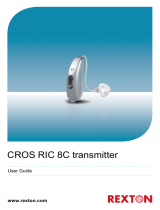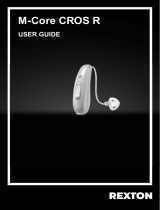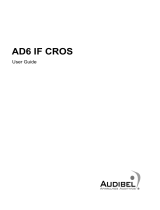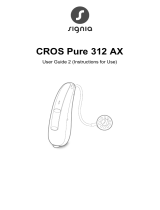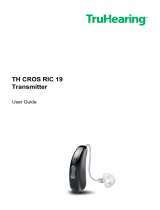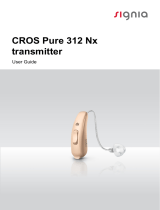Page is loading ...

M-Core CROS iX-CIC
USER GUIDE 2
(Instructions for Use)

CAUTION
It is important to read this user guide and the
user guide 1 (safety manual) thoroughly and
completely. Follow the safety information to
avoid damage or injury.
3

4
CONTENT
Welcome 6
Your CROS transmitter 7
Components and names 9
Signal tones 10
Batteries 11
Battery size and handling tips 11
Replacing batteries 12
Daily use 13
Turning on and off 13
Inserting and removing the transmitter 13
Maintenance and care 17
Transmitter 17
Ear pieces 18
Professional maintenance 21
Further information 22
Explanation of symbols 22
Operating, transport and storage conditions 23
Troubleshooting 24
Disposal information 24
Conformance information 25
Country-specific information 27
Important safety information 28
Personal safety 28
Product safety 30
Service and warranty 33
5

6 7
WELCOME
Thank you for choosing one of our hearing instrument
accessories.
This guide, along with support from your Hearing Care
Professional, will help you understand the advantages and
greater quality of life this accessory offers.
CAUTION
It is important to read this user guide thoroughly and
completely. Follow the safety information to avoid
damage or injury.
YOUR CROS TRANSMITTER
CROS solutions are designed for people with profound
hearing loss in one ear which can not be aided with a
hearing instrument. A CROS transmitter worn on this ear
captures sound from this side and transmits it to the hearing
instrument on the other ear. This allows the wearer of the
hearing instrument to hear sounds from both sides.
CROS transmitter hearing instrument

8 9
Two solutions are available:
■CROS solution:
For people with normal hearing in one ear and profound
hearing loss in the other. Sounds from the side with
hearing loss are captured and transmitted wirelessly to
the good-hearing side.
■BiCROS solution:
For people with profound hearing loss in one ear and less
severe hearing loss in the other. Sounds from the more
severe hearing loss side are captured and transmitted
wirelessly to the better-hearing side. The hearing
instrument processes and amplifies the sounds from both
sides.
The CROS transmitter works with our specific wireless
hearing instruments. Your Hearing Care Professional will
advise you on the compatible models.
NOTICE
This user guide only applies to the CROS transmitter.
Your hearing instrument has a separate user guide.
COMPONENTS AND NAMES
➊
➋
➌
➍
Ear piece (Click Sleeve)
➋ Microphone
➌ Battery compartment
(on/off switch)
➍ Removal cord
You can use the following standard ear pieces:
Standard ear pieces Size
Click Sleeve (vented or closed)
Click Dome™ single
(open or closed)
Click Dome semi-open
Click Dome double
You can easily exchange the standard ear pieces. Read more
in section "Maintenance and care".
➊

10 11
SIGNAL TONES
Signal tones of the CROS transmitter - like a low battery
beep - are sent to the hearing instrument.
Ask your Hearing Care Professional to configure the signal
tones.
BATTERIES
When the battery is low the sound becomes weaker or you
will hear an alert signal. The battery type will determine how
long you have to replace the battery.
BATTERY SIZE AND HANDLING TIPS
Ask your Hearing Care Professional for recommended
batteries.
Battery size: 10
■The "battery low" signal of the CROS transmitter and
the "battery low" signal of the hearing instrument have
different melodies.
■Always use the correct battery size for your device.
■Remove the batteries if you intend not to use the device
for several days.
■Always carry spare batteries.
■Remove empty batteries immediately and follow your
local recycling rules for battery disposal.

12 13
REPLACING BATTERIES
Removing the battery:
Open the battery
compartment.
Remove the battery by
hand.
Inserting the battery:
If the battery has a protective film, remove it
only when you are ready to use the battery.
Insert the battery with the
"+" symbol facing upwards.
Carefully close the battery compartment. If you feel
resistance, the battery is not inserted correctly.
Do not attempt to close the battery compartment by force.
It can be damaged.
DAILY USE
TURNING ON AND OFF
Turning on: Close the battery compartment.
The transmitter turns on after a delay of several seconds
(power-on delay).
Turning off: Open the battery compartment.
INSERTING AND REMOVING THE TRANSMITTER
CAUTION
Risk of injury!
Always wear the device with an ear piece.
Make sure that the ear piece is completely
attached.
Inserting:
Identify right and left device so that you insert it in
the correct ear. The labeling or the color of the device
indicates the side:
red color, imprinted "R" = right ear
blue color, imprinted "L" = left ear
Take care that the flap of the Click Sleeve matches the
line printed on the device.

14 15
correct incorrect
Hold the device correctly before inserting it: Pay special
attention to the removal cord indicating the bottom.
The arrow which is printed on the device has to point
upwards.
L R
Carefully push the device
into the ear canal.
Twist it slightly until it sits
well.
Open and close your mouth
to avoid accumulation of air
in the ear canal.
CAUTION
Risk of injury!
Insert the device carefully and not too deeply into
the ear.
■It may be helpful to insert the right device with the
right hand and the left device with the left hand.
■If you have problems inserting the device, use the
other hand to gently pull your earlobe downwards.
This opens the ear canal and eases insertion of the
device.

16 17
Removing:
NOTICE
Never pull on the battery compartment door to
remove the device. This could damage the device.
Push lightly on the back of your ear to loosen the device.
Remove the device by pulling the removal cord towards
the back of your head.
CAUTION
Risk of injury!
In very rare cases the ear piece could remain
in your ear when removing the device. If this
happens, have the ear piece removed by a medical
professional.
Clean and dry your device after usage. Read more in section
"Maintenance and care".
MAINTENANCE AND CARE
To prevent damage it is important that you take care of your
device and follow a few basic rules, which will soon become
a part of your daily routine.
TRANSMITTER
DRYING AND STORAGE
Dry your device overnight.
For longer periods of non-use, store your device in a dry
environment with an open battery compartment and the
batteries removed.
Ask your Hearing Care Professional for more information.
CLEANING
Your device has a protective coating. However, if not cleaned
regularly you may damage the device or cause personal
injury.
Clean your device daily with a soft, dry tissue.
Never use running water or immerse the
device in water.
Never apply pressure while cleaning.
Ask your Hearing Care Professional for recommended
cleaning products, special care sets, or more information
on how to keep your device in good condition.

18 19
EAR PIECES
CLEANING
Cerumen (ear wax) may accumulate on the ear pieces. This
may affect sound quality. Clean the ear pieces daily.
Clean the
ear piece right
after removal
with a soft and
dry tissue.
This prevents
that cerumen
becomes dry
and hard.
Squeeze the tip of the ear piece.
EXCHANGING
Exchange standard ear pieces approximately every three
months. Replace them sooner if you notice cracks or
other changes. The procedure for exchanging standard
ear pieces depends on the type of ear piece. In section
"Components and names", your Hearing Care Professional
has marked your type of ear piece.
EXCHANGING CLICK SLEEVES
Grip the Click Sleeve with your fingers and pull it off. If
you cannot grip it, turn it inside out and then pull it off.
Take particular care that
the new Click Sleeve clicks
noticeably in place.
click

20 21
When installing the new Click Sleeve, take care that the
flap of the Click Sleeve matches the line printed on the
device.
correct incorrect
EXCHANGING CLICK DOMES
If you have problems removing the old Click Dome, follow
the instructions on the packaging of the Click Domes.
Take particular care that the
new Click Dome attaches with
a noticeable "click".
PROFESSIONAL MAINTENANCE
Your Hearing Care Professional can perform a thorough
professional cleaning and maintenance.
Ask your Hearing Care Professional for your individual
recommendation of maintenance intervals and for support.
click

22 23
FURTHER INFORMATION
EXPLANATION OF SYMBOLS
Symbols used in this document
Points out a situation that could lead to serious,
moderate, or minor injuries.
Indicates possible property damage.
Advice and tips on how to handle your device better.
Symbols on the device or packaging
0123
CE compliance label, confirms compliance with
certain European Directives, refer to section
"Conformance information".
EMC and radio communications
compliance label Australia, refer to section
"Conformance information".
Indicates the legal manufacturer of the device.
Do not dispose of the device with general domestic
waste. Read more in section "Disposal information".
Read and follow the instructions in the user guide.
Symbols on the device or packaging
Medical device
OPERATING, TRANSPORT AND STORAGE CONDITIONS
Operating conditions
Temperature 0 to 50 °C (32 to 122 °F)
Relative humidity 5 to 93 %
During extended periods of transport and storage, please
observe the following conditions:
Storage Transport
Temperature 10 to 40 °C
(50 to 104 °F)
-20 to 60 °C
(-4 to 140 °F)
Relative
humidity
10 to 80 % 5 to 90 %
For other parts, such as batteries, other conditions may
apply.

24 25
TROUBLESHOOTING
Problem and possible solutions
Hearing instrument emits signal tones.
■Replace the empty battery of the transmitter.
Read more in section "Signal tones".
Transmitter does not work.
■Turn the transmitter on.
■Gently close the battery compartment completely.
■Replace the empty battery.
■Make sure the battery is inserted correctly.
■Power-on delay is active. Wait several seconds and
check again.
Consult your Hearing Care Professional if you encounter
further problems.
DISPOSAL INFORMATION
Recycle hearing instruments, accessories and packaging
according to local regulations.
To avoid environmental pollution, do not throw batteries
into household trash.
Recycle or dispose of batteries according to local
regulations or return them to your Hearing Care
Professional.
CONFORMANCE INFORMATION
The CE mark indicates conformity with the following
European directives:
■93/42/EEC concerning medical devices
■2014/53/EU RED concerning radio equipment
■2011/65/EU RoHS concerning the restriction of
hazardous substances
The full text of the declaration of conformity can be obtained
from www.sivantos.com/doc.
The ACMA compliance mark indicates conformity
with the electromagnetic interference standards set by the
Australian Communications and Media Authority (ACMA).
Devices with the FCC marking comply with the standards of
the FCC regarding electromagnetic interference.
This Class B digital apparatus complies with Canadian
ICES-003.
This device complies with Part 15 of the FCC Rules and with
ISED's licence-exempt RSSs.
Operation is subject to the following two conditions:
■This device may not cause harmful interference, and
■this device must accept any interference received,
including interference that may cause undesired
operation.

26 27
This equipment has been tested and found to comply with
the limits for a Class B digital device, pursuant to Part 15
of the FCC Rules. These limits are designed to provide
reasonable protection against harmful interference in a
residential installation. This equipment generates, uses
and can radiate radio frequency energy and, if not installed
and used in accordance with the instructions, may cause
harmful interference to radio communications. However,
there is no guarantee that interference will not occur in a
particular installation. If this equipment does cause harmful
interference to radio or television reception, which can be
determined by turning the equipment off and on, the user is
encouraged to try to correct the interference by one or more
of the following measures:
■Reorient or relocate the receiving antenna.
■Increase the separation between the equipment and
receiver.
■Connect the equipment to an outlet on a circuit different
from that to which the receiver is connected.
■Consult the dealer or an experienced radio/TV technician
for help.
FCC caution: Any changes or modifications not expressly
approved by the party responsible for compliance could void
the user's authority to operate this equipment.
COUNTRYSPECIFIC INFORMATION
USA AND CANADA
This device with wireless functionality is certified under:
M-Core CROS iX-CIC
■NFMI Module 2
■Contains FCC ID: SGI-MIM002
■Contains IC: 267AB-MIM002

28 29
IMPORTANT SAFETY INFORMATION
PERSONAL SAFETY
This device is not intended for children under the age of
3 years or persons with a developmental age of under
3 years.
WARNING
Risk of affecting electronic equipment!
In areas where the use of electronics or wireless
devices are restricted, verify if your device has to
be turned off.
WARNING
Risk of injury!
Do not use obviously damaged devices and return
them to point of sale.
WARNING
Note that any unauthorized changes to the product
may cause damage to the product or cause injury.
Use only approved parts and accessories. Ask your
Hearing Care Professional for support.
WARNING
Choking hazard!
Your device contains small parts which can be
swallowed.
Keep hearing instruments, batteries and
accessories out of reach of children and mentally
disabled persons.
If parts have been swallowed consult a physician or
hospital immediately.
WARNING
Your device may reduce certain background sounds,
potentially also traffic or warning signals.
WARNING
Risk of explosion!
Do not use your device in explosive atmospheres
(e. g. in mining areas).
CONTRAINDICATIONS
WARNING
Consult a Hearing Care Professional if you experience
any unusual side effects like skin irritation, excessive
accumulation of ear wax, dizziness, change in your
hearing, or if you think there may be a foreign object in
your ear canal.

30 31
WARNING
A Hearing Care Professional should advise a
prospective device user to consult a licensed
physician before using the device if the Hearing Care
Professional determines that the prospective user has
any of the following conditions:
Visible congenital or traumatic deformity of the ear.
History of active drainage from the ear within the
previous 90 days.
History of sudden or rapidly progressive hearing
loss within the previous 90 days.
Acute or chronic dizziness.
Unilateral hearing loss of sudden or recent onset
within the previous 90 days.
Audiometric air-bone gap equal to or greater than
15 dB at 500 Hz, 1,000 Hz, and 2,000 Hz.
Visible evidence of significant cerumen
accumulation or a foreign body in the ear canal.
Pain or discomfort in the ear.
PRODUCT SAFETY
NOTICE
Only use zinc-air batteries or nickel-metal hydride
(NiMH) rechargeable batteries.
Do not use e.g. silver-zinc or lithium-ion rechargeable
batteries.
NOTICE
Protect your devices from extreme heat. Do not
expose them to direct sunlight.
NOTICE
Do not dry your devices in the microwave oven.
NOTICE
Different types of strong radiation, e. g. during X-ray or
MRI head examinations, may damage devices.
Do not use the devices during these or similar
procedures.
Weaker radiation, e. g. from radio equipment or
airport security, does not damage the devices.
NOTICE
Protect your devices from high humidity. Do not
wear them in the shower or when you apply
make-up, perfume, aftershave, hairspray or suntan
lotion.
In some countries restrictions for the usage of
wireless equipment exist.
Refer to local authorities for further information.

32 33
NOTICE
Your devices are designed to comply with international
standards on electromagnetic compatibility but
interference with nearby electronic devices could
occur. In this case, move away from the source of
interference.
NOTICE
Your devices comply with international standards.
However, it cannot be guaranteed that all products on
the market work interference-free, for example some
induction cookers may cause audible interference.
SERVICE AND WARRANTY
Serial numbers
Left:
Right:
Service dates
1: 4:
2: 5:
3: 6:
Warranty
Date of purchase:
Warranty period in months:
Your Hearing Care Professional

M-Core CROS iX-CIC
MANUAL DEL OPERADOR 2
(Instrucciones de uso)

35
CAUTION
Es importante que leas detenidamente este
manualdel operator y el manual del operator 1
(manual de seguridad) de principio a fin.
Sigue la información de seguridad para evitar
daños o lesiones.
36
CONTENIDOS
Bienvenido 38
Su transmisor CROS 39
Componentes y nombres 41
Tonos de aviso 42
Pilas 43
Tamaño de la pila y consejos para el manejo 43
Sustituir las pilas 44
Uso diario 45
Conexión y desconexión 45
Inserción y extracción del transmisor 45
Mantenimiento y cuidados 49
Transmisor 49
Moldes 50
Mantenimiento profesional 53
Información adicional 54
Explicación de los símbolos 54
Condiciones de manejo, transporte y almacenamiento 55
Solución de problemas 56
Información sobre la eliminación 56
Información de conformidad 57
Información específica por país 59

38
37
BIENVENIDO
Gracias por elegir nuestros accesorios para audífonos.
Con este manual y con la ayuda su especialista en audición
descubrirá las ventajas y la mejora en la calidad de vida que
le ofrece este accesorio.
ATENCIÓN
Es importante que lea detenidamente este manual
del operador de principio a fin. Siga la información de
seguridad para evitar daños o lesiones.
Información importante de seguridad 60
Seguridad personal 60
Seguridad del producto 63
Servicio y garantía 65
/



